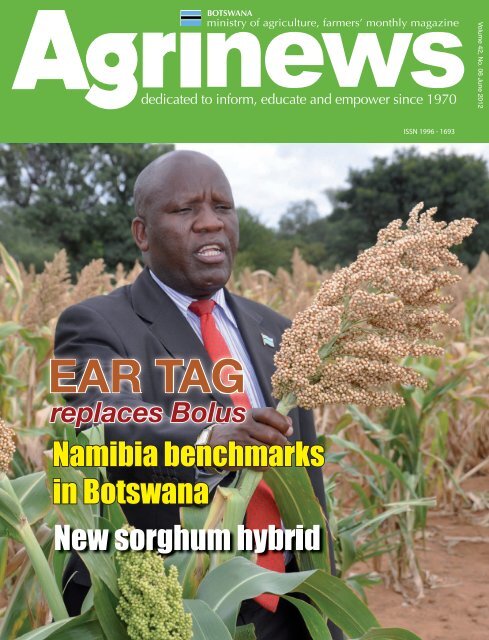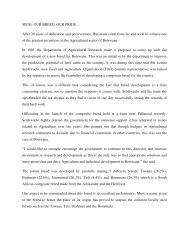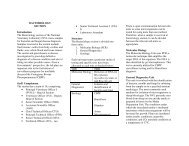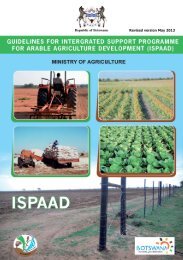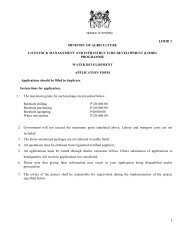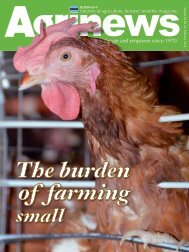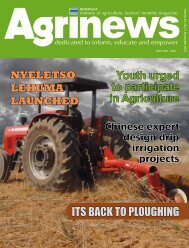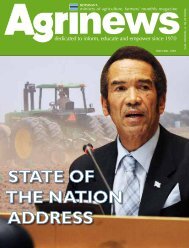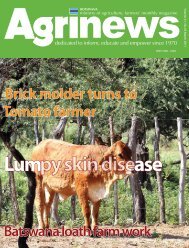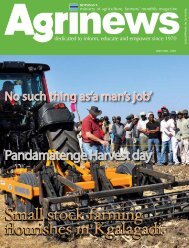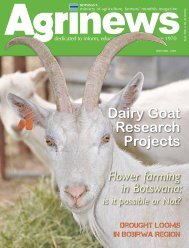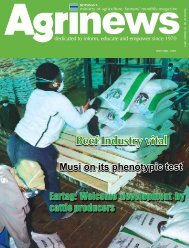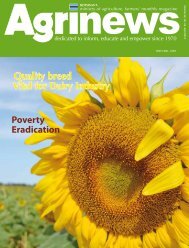June Agrinews 2012-13.indd - Ministry of Agriculture
June Agrinews 2012-13.indd - Ministry of Agriculture
June Agrinews 2012-13.indd - Ministry of Agriculture
You also want an ePaper? Increase the reach of your titles
YUMPU automatically turns print PDFs into web optimized ePapers that Google loves.
Volume 42, No. 06 <strong>June</strong> <strong>2012</strong><br />
EAR TAG<br />
replaces Bolus<br />
Namibia benchmarks<br />
in Botswana
<strong>June</strong> <strong>2012</strong>
NATIONAL AGRICULTURAL SHOW<br />
Transforming <strong>Agriculture</strong> In The Wake Of Climate Change<br />
NEW AGRICULTURAL SHOW GROUND - Sebele<br />
2 August - 1 September <strong>2012</strong><br />
For more information call 3689115<br />
<strong>June</strong> <strong>2012</strong>
AGRINEWS<br />
<strong>June</strong><br />
<strong>2012</strong><br />
Contents<br />
New sorghum hybrid<br />
Twin calves in Mahalapye sudistrict<br />
Vermicompost - the way to go<br />
Going strong since 1969<br />
Cluster fencing enhances production<br />
Namibia benchmarks in Botswana<br />
Electronic and Analogue eartag<br />
2<br />
4<br />
5<br />
6<br />
8<br />
10<br />
16<br />
Lopang - Simmental beef breeder<br />
MITC merges with BCA<br />
12<br />
13<br />
8<br />
Aphids & low rains hinders growth <strong>of</strong><br />
beans in Gantsi<br />
LIMID transforms widow’s life<br />
How to become a successful farmer<br />
14<br />
16<br />
17<br />
10<br />
2<br />
Vacant<br />
Editor:<br />
Moreri Moesi<br />
Reporters:<br />
France Begensel<br />
Segomotso Basuti<br />
Keamogetse Boitshepo<br />
Kesog<strong>of</strong>etse Tawele<br />
Mokgarebe Motswakhumo<br />
Esther Nkgwang<br />
Modiegi Madumetsa<br />
Khutsafalo Maabong<br />
Keabetswe Molebatsi<br />
Designer:<br />
Moreri Modipe<br />
Head Of Photography<br />
Henry Toto<br />
Photographers:<br />
Pius Nkunda<br />
Aggripah Willie
FOUNDATION<br />
PILLARS<br />
editor’s note<br />
VISION<br />
Attain national food security<br />
and global competitiveness<br />
in agricultural products<br />
FARMERS MUST RUN AGRICULTURAL SHOWS<br />
MISSION<br />
To improve agricultural productivity<br />
through technology development<br />
and transfer, diversification and<br />
commercialization, in order<br />
to promote food security in<br />
partnership with our stakeholders.<br />
VALUES<br />
1. BOTHO<br />
We treat our customers in<br />
a respectable and caring manner.<br />
2. TEAM WORK<br />
We recognize the need to work as<br />
a team characterized by collective<br />
effort, trust, understanding,<br />
support and perseverance<br />
irrespective <strong>of</strong> rank or gender.<br />
3. CUSTOMER FOCUSED<br />
Our customers are the focus<br />
<strong>of</strong> everything we do by being<br />
courteous, caring, compassionate,<br />
tolerant and empathetic.<br />
4. INNOVATIVE<br />
We commit to employ new ideas<br />
and being proactive in order to<br />
match the requirements <strong>of</strong> the<br />
future.<br />
5. INTEGRITY<br />
We foster a culture <strong>of</strong> transparency,<br />
accountability and dependability.<br />
No country can afford to produce<br />
enough food without the full<br />
participation <strong>of</strong> its citizens.<br />
Many at times, some people<br />
believe that the government<br />
alone must do everything for<br />
them every time.<br />
Governments throughout the<br />
world do certain things to uplift<br />
the living standard <strong>of</strong> their<br />
citizen. In other words, such<br />
assistance has to cease at some<br />
pointing time. The stoppage<br />
<strong>of</strong> that assistance can occur<br />
depending on the prevailing<br />
circumstances <strong>of</strong> the time.<br />
One example where the<br />
government, through the<br />
<strong>Ministry</strong> <strong>of</strong> <strong>Agriculture</strong> has been<br />
providing valuable assistance is<br />
the agricultural shows.<br />
Every year, ministry <strong>of</strong>ficials<br />
always lead the preparation for<br />
such shows. In some areas, the<br />
number <strong>of</strong> government <strong>of</strong>ficials<br />
in the show committees even<br />
exceed that <strong>of</strong> farmers.<br />
However, it should be noted that<br />
ministry <strong>of</strong>ficials should instead<br />
advise such show committees.<br />
How long will this continue?<br />
This is the question to the<br />
farmers <strong>of</strong> this country. One is<br />
tempted to cite as an exception,<br />
the Ghanzi Agricultural show<br />
which is now a brand.<br />
It is a brand because the captains<br />
<strong>of</strong> the farming industry are in the<br />
forefront. Government <strong>of</strong>ficials<br />
only advise the committee. This<br />
is the secret <strong>of</strong> Ghanzi show.<br />
Therefore, <strong>Agrinews</strong> makes<br />
this clarion call to farmers and<br />
the business community <strong>of</strong><br />
this country that the time is<br />
now. Farmers must take over<br />
the running <strong>of</strong> the shows<br />
and move towards their<br />
commercialization.<br />
However, the farmers cannot<br />
manage without the involvement<br />
<strong>of</strong> the private sector. We are<br />
therefore calling on the private<br />
sector to partner with farmers<br />
and make agricultural shows<br />
a darling for Batswana and the<br />
rest <strong>of</strong> the world.<br />
i
Article: K eseg<strong>of</strong>etse Tawele<br />
Photos: Aggripah Willie<br />
Ploughing <strong>of</strong> sorghum started in<br />
Africa. It is the staple food <strong>of</strong><br />
most African countries, but over<br />
the years most farmers in Botswana<br />
have abandoned this crop and have<br />
resorted to ploughing maize. In the<br />
past few years, the Department <strong>of</strong><br />
Agricultural Research, <strong>Ministry</strong> <strong>of</strong><br />
<strong>Agriculture</strong> developed a new breed <strong>of</strong><br />
sorghum, Botswana Sorghum Hybrid<br />
1 (BSH1). BSH1 was developed<br />
to answer farmers’ plight <strong>of</strong> the<br />
challenges faced with the current<br />
varieties <strong>of</strong> sorghum. They are unable<br />
to resist the current unpredictable and<br />
changing climatic conditions.<br />
BSH1 was the first hybrid the<br />
department developed in 2007. It does<br />
well under the current conditions. It has<br />
proved to be better in yield potential<br />
than the traditional varieties used by<br />
most farmers. For example, it has a<br />
yield potential <strong>of</strong> 3.0 to 6.0 tonnes per<br />
hectare that is approximately 120 bags<br />
per hectare, compared to Segaolane<br />
cultivar which has a yield potential <strong>of</strong><br />
1.0 to 3.5 tonnes per hectare. BSH1<br />
reaches maturity in 120 to 130 days.<br />
The development <strong>of</strong> the new hybrid<br />
<strong>of</strong> sorghum together with BSH1 will<br />
further answer the farmers’ plight<br />
<strong>of</strong> low yields due to the unreliable<br />
rainfall the country is experiencing.<br />
These crops are mule crops; that is<br />
they cannot be replanted (harvested<br />
seeds cannot be stored for replanting<br />
in the coming season as it is usually<br />
done with the traditional cultivars).<br />
The seeds harvested by the farmer are<br />
solely for consumption only.<br />
Dr Steven Chite, the breeder in<br />
the Department <strong>of</strong> Agricultural<br />
Research explained that the mule<br />
crop has two parents which are<br />
planted side by side and<br />
then cross pollination<br />
occurs resulting in<br />
a hybrid. The yet to<br />
be named hybrid<br />
crop has different<br />
characteristics to<br />
traditional crops like<br />
Segaolane, Mahube,<br />
Marupaantse,<br />
Sephala and even<br />
BSH1 in that it is<br />
tan, some crops<br />
when wounded or<br />
attacked by mites<br />
(diboko) they develop<br />
a red powder in their<br />
stem (mogwang) which<br />
ultimately stain the meal,<br />
whereas the new crop<br />
remain white ensuring<br />
white meal at all times. Its<br />
stem stays green until harvest,<br />
while other crops dry up and<br />
turn brownish when they reach<br />
full maturity. Moreover, it has<br />
short segments which make its<br />
height conducive for both hand and<br />
machine harvesting.<br />
The new crop proves to have more<br />
yield potential because one plant<br />
produces about seven heads (diphara).<br />
It has a yield potential <strong>of</strong> one hundred<br />
50kg bags per hectare. However, the<br />
crop is also susceptible to Quelea<br />
birds invasion like any other sorghum<br />
crop. Therefore, farmers would have to<br />
be ready to chase the birds if they are<br />
to obtain maximum yields.<br />
The department planted this crop on<br />
the field for the first time on December<br />
13, 2011at different districts across the<br />
country to see how it does in different<br />
climatic conditions. It was ploughed<br />
alongside tswana crops like segaolane,<br />
Marupaantse, Sephala, Mahube and<br />
BSH1. The new hybrid and BSH1 did<br />
best compared to Tswana varieties.<br />
They showed similarities like big<br />
heads and white seeds, and they are<br />
semi dwarf in height and they both<br />
have higher yield potential. However,<br />
Batswana have to wait for about five<br />
years for the new crop to be availed<br />
to them as research is still ongoing.<br />
After harvest the new crop has to<br />
undergo further testing in terms <strong>of</strong><br />
taste, whether its porridge or beer<br />
tasty. The National Food Research<br />
Technology Centre (NAFTEC) has<br />
been engaged for such testing. The<br />
crop will be named afetr completion<br />
<strong>of</strong> those tests.<br />
<strong>June</strong> <strong>2012</strong> 2
Balosang Moremi and his wife admiring their twin calves<br />
Twin Calves in Mahalapye Sub district<br />
Article: Keamogetse Boitshepo<br />
Photos: Aggripah Willie<br />
Although twin calves are<br />
scientifically not out <strong>of</strong> the<br />
ordinary, for Balosang Moremi it<br />
was a rare occasion, that does not only<br />
increase his calving percentage, but<br />
imply that this year will be a blissful<br />
one for him and his family.<br />
February 10, is a historic date to the<br />
Moremi family because for the first<br />
time in their history one <strong>of</strong> their cows<br />
gave birth to twins.<br />
In disbelieve <strong>of</strong> what they could have<br />
dismissed as calf stealing by a cow,<br />
Moremi said the calves were quickly<br />
separated from the cow hoping for<br />
natural instinct to connect the real calf<br />
with its mother. This proved fruitless<br />
when both calves were drawn to the<br />
same cow.<br />
“It was not the only cow that was<br />
pregnant in my flock at the time. We<br />
made an assessment and found that<br />
no other cow had given birth that<br />
particular night. So, we are certain that<br />
the calves belong to the same cow.”<br />
With these conclusive facts, Moremi<br />
turned to his elders to find out what<br />
this could mean, since he had never<br />
seen it in his eight year farming<br />
experience nor had he heard about it<br />
in his life time.<br />
“To my knowledge, it has never<br />
happened to any <strong>of</strong> my relatives. I<br />
have always known goats to be the<br />
ones that can give birth to twins not<br />
cows. However, I learned that the<br />
incident shows that <strong>2012</strong> will be a<br />
blessed year <strong>of</strong> growth.”<br />
Moremi keeps Limousin bull and<br />
Brahman cows in Magwata cattle<br />
post in the Mahalapye sub district<br />
extension area. His choice <strong>of</strong> breed<br />
which he confessed to be rearing by<br />
default, is paying <strong>of</strong>f since the breeds<br />
have good quality beef, productivity<br />
rate and suffi cient milk to feed the<br />
young ones. Even though he knew<br />
the cows to have suffi cient milk he<br />
did not think it would be enough for<br />
twin calves. To his surprise, the cow<br />
has enough milk to feed both calves.<br />
However, Moremi admits the twin<br />
mother is now an exception by not<br />
milking it. This, he said will go on for<br />
at least two months to ensure that the<br />
calves grow properly.<br />
Assessing his farming method to<br />
check what could have caused his<br />
luck, Moremi does not do anything<br />
different from other farmers in the area.<br />
He releases cattle to look for pastures<br />
in the evening and supplement with<br />
winter lick and salt.<br />
The news that carries excitement<br />
and hope for the Moremi family,<br />
scientifically they may carry no<br />
meaning at all. Dr Letlhogile Modisa,<br />
Director <strong>of</strong> Animal Production,<br />
3<br />
<strong>Ministry</strong> <strong>of</strong> <strong>Agriculture</strong> said for a cow<br />
to have twins is a chance event like it is<br />
with human beings. Cows, according<br />
to Modisa also have fraternal and<br />
identical twins as such they can<br />
be <strong>of</strong> the different or same gender<br />
respectively.<br />
“Twin calves are a matter <strong>of</strong> probability<br />
just like in human beings. The calves<br />
are as normal as those that are born<br />
individually, especially if they are<br />
fed well. However, scientifically it<br />
is generally observed that a heifer<br />
which is born as a twin <strong>of</strong> a male is<br />
usually sterile and this is referred to as<br />
Freemartinism.”<br />
Modisa said calving <strong>of</strong> twins is entirely<br />
natural therefore cannot be associated<br />
to feed type or any particular breed.<br />
However, Modisa does not deny that<br />
good farming conditions and good<br />
feed enhance production rate though<br />
it does not imply that the cows will<br />
have twins. Some plants may have<br />
some hormones that may cause<br />
superovulation and possibly twins as<br />
a result, but generally the phenomena<br />
<strong>of</strong> twins is not well understood.<br />
Modisa noted that it is difficult to tell<br />
the rate <strong>of</strong> twin production in the<br />
country considering the commonly<br />
used free range farming system. He<br />
said chances <strong>of</strong> unrecorded incidences<br />
<strong>of</strong> still born twins and lost calves<br />
which would be left to die <strong>of</strong> hunger<br />
or predators could be high.<br />
<strong>June</strong> <strong>2012</strong>
Vermicompost; the wa<br />
Article France Begensel<br />
Photos: Aggripah Willie<br />
Doing piece jobs did not dwell<br />
well in the mind <strong>of</strong> Onalenna<br />
Matlapeng 32, <strong>of</strong> Tlokweng.<br />
Working as a binder for Printing and<br />
Publishing Company Botswana could<br />
not put enough food on the table or<br />
dress her. The only way she could do<br />
something about her life was if she<br />
engaged in an agricultural project <strong>of</strong><br />
some sort.<br />
Exploring different agricultural<br />
avenues, she came to settle for<br />
horticulture and beekeeping. “That<br />
was not enough as I still wanted to do<br />
something that could not pose danger<br />
to the environment. As I thought<br />
about artifi cial fertilizer and what it<br />
does to the soil and artmosphere after<br />
a long time I decided to settle for<br />
environment cleaners like bees.” She<br />
also decided to engage in something<br />
environmentallly friendly to nourish<br />
her vegetables.<br />
Matlapeng says that this is where the<br />
idea <strong>of</strong> worm compost came from.<br />
Worm composting is using worms<br />
to recycle food scraps and other<br />
organic material into a valuable soil<br />
amendment called vermicompost,<br />
or worm compost. Worms eat food<br />
scraps, which become compost as<br />
they pass through the worm’s body.<br />
Compost exits the worm through its<br />
tail end. This compost can be used<br />
to grow plants. To understand why<br />
vermicompost is good for plants,<br />
remember that the worms are eating<br />
nutrient-rich fruit and vegetable<br />
scraps, and turning them into nutrient<br />
rich compost (Jen Fong and Paula<br />
Hewitt:2009).<br />
The form five leaver says started her<br />
worm compost project this year. She<br />
developed interest in this kind <strong>of</strong><br />
project because the compost does not<br />
harm the environment. “ I realised that<br />
I could use it as a source <strong>of</strong> income.”<br />
Above all, she discloses that she an<br />
ally <strong>of</strong> organic farming.<br />
Prior to starting her project she went<br />
for benchemarking and mentoring<br />
at Tshomarelo Tikologo where she<br />
was advised on how to go about<br />
the worm composting exercise.The<br />
Department <strong>of</strong> Agricultural Research<br />
also imparted valuable knowledge<br />
through workshops on verrmi<br />
composting.<br />
She reveals that she uses only raw<br />
fruits and vegetable scraps, kraal<br />
manure and pieces <strong>of</strong> paper, adding<br />
that the paper should only be black<br />
and white. She says that food such as<br />
meat, dairy products and oils should<br />
be avoided at all costs. She says that<br />
these are very complex materials that<br />
are diffi cult for the worms to digest.<br />
Thus, they take longer to break down<br />
and can attract pests. She reveals that<br />
<strong>June</strong> <strong>2012</strong> 4
y to go<br />
cooked foods are <strong>of</strong>ten oily which can<br />
also attract pests such as ants.<br />
Orange rinds and other citrus fruits,<br />
which are too acidic can also attract<br />
fruit flies. It is though advised that a<br />
variety <strong>of</strong> materials could be used.<br />
It has also been discovered that the<br />
more vegetable matter, the better the<br />
worm compost. Other vegetables<br />
to avoid at all costs are onions and<br />
broccoli because they tend to have<br />
a strong odour (Jen Fong & Paula<br />
Hewitt).<br />
“Setting up a place where you keep<br />
your worms is very easy and cheap.”<br />
She uses old tyres to house the worms.<br />
She adds that moist newspaper strips<br />
and clay to loamy soils are a good<br />
habitation for them, especially if some<br />
kraal manure has been added. She<br />
is quick to point out that the habitat<br />
requires constant watering to keep it<br />
moist.<br />
She adds that she started with with one<br />
tyre but currently has two and another<br />
one in a metal tub. The former PPCB<br />
employee reveals that she started with<br />
100 worms and they have multiplied<br />
to more than a 1000. She adds that the<br />
worms lay eggs and hatch after every<br />
two months.<br />
Matlapeng says that when you notice<br />
less and less bedding and more and<br />
more <strong>of</strong> compost in your tyre, it is<br />
time for harvesting, which is done<br />
by removing the finished compost<br />
from the tyre. She points out that if<br />
worms are well taken care <strong>of</strong> under<br />
a favourable environment, they will<br />
work tirelessly to eat garbage and<br />
produce more compost.<br />
She reveals that harvesting is done by<br />
pushing the worms to the other side <strong>of</strong><br />
the tyre, removing any large pieces <strong>of</strong><br />
undercomposed food or newspapers.<br />
“Put fresh bedding and food scraps in<br />
an empty side <strong>of</strong> tyre burying food<br />
scraps only in freshly bedded half.”<br />
She says that one can now collect the<br />
compost and use as it is ready.<br />
She says that many people are<br />
interested in buying her worm compost<br />
as it brings no harm to them or<br />
environment. She did some research<br />
for a year to establish the economic<br />
value <strong>of</strong> the project. She says that<br />
organic farming is advantageous<br />
compared to artificial fertilizers<br />
because <strong>of</strong> the dangers associated<br />
with the latter. “With worm compost<br />
it can be used by everyone including<br />
those who can not read because it is<br />
not harmful in any way.<br />
Although she just started she has<br />
not experienced any problems, but<br />
says if left uncovered birds could be<br />
a menace as they would feast on the<br />
worms. She says ants and mice can<br />
also be a problem.<br />
Ugele Majeule, Principal <strong>Agriculture</strong><br />
Research Officer, Department <strong>of</strong><br />
Agricultural Research shares the same<br />
sentiments with Matlapeng. Majeule<br />
is quick to reveal that they carried out<br />
the project after the President visited<br />
Cuba where he came across such a<br />
project. He says that this could be<br />
a pr<strong>of</strong>itable and healthy project if<br />
done properly. He adds that they are<br />
also engaged in a similar project at<br />
Sunnyside Farm near Lobatse. He<br />
points out that they started only a few<br />
months ago and they have just made<br />
their first harvest.<br />
He says that since the project is still at<br />
its infancy stage they have not rolled<br />
it out to potential farmers as there<br />
are still a lot <strong>of</strong> reseach to be done.<br />
He says that their current harvest is<br />
basically for tests, adding that they<br />
are to determine yield benefits and<br />
soil quality improvement.<br />
Majeule says that they are doing<br />
the project under different<br />
conditions like netshading,<br />
trenches and tyres. He says this<br />
would best show them on which<br />
conditions to adhere to.<br />
The project will be rolled out to<br />
potential farmers once research<br />
has been successful. He adds<br />
that they will target agriculture<br />
farmers,the fish industry and<br />
also councils which at times<br />
struggle with organic disposal.<br />
He says that once they establish<br />
the viability <strong>of</strong> the project they<br />
will roll produce management<br />
materials like videos, booklets<br />
and pamphlets.<br />
For Onalenna Matlapeng<br />
determination, dedication and<br />
passion would carry her through<br />
the struggle she finds herself<br />
in. She is though very hopeful<br />
that she will be amongst the<br />
suppliers <strong>of</strong> environmental<br />
friendly compost.<br />
<strong>June</strong> <strong>2012</strong>
Going strong since 1969<br />
Article: Segomotso Basuti<br />
Photos: Pius Nkunda<br />
Mr Milton Dikgale reminisces the<br />
harsh olden days when they would<br />
wake up early in the morning to chase<br />
cattle out <strong>of</strong> their fields so they would<br />
not destroy their crops. Barefoot,<br />
they would playfully run around the<br />
fields. To their elders, growing crops<br />
was done with such delicacy. No<br />
one would want to go through the<br />
streneous process <strong>of</strong> farming only to<br />
have their harvest destroyed by cattle.<br />
“Though, I was a little boy I still<br />
remember the events like it was<br />
yesterday, what amazes me is the<br />
passion our fathers had,” he said.<br />
Still caught in the moment, Dikgale<br />
narrates that for the people <strong>of</strong><br />
Leshibitse using the latest methods<br />
<strong>of</strong> farming is not new. This has been<br />
their ritual since farming started in<br />
their area in 1969. In these years, their<br />
<strong>Agriculture</strong> demonstrator would cycle<br />
from Mookane to ensure that when<br />
the time came for farmers across the<br />
country to harvest what they had sown,<br />
his district would also have something<br />
to show.<br />
The hard work endured by farmers was<br />
not in vain or just to ensure that their<br />
families were provided for. According<br />
to Dikgale, there were competitions<br />
that were held during the ploughing<br />
season. These kept farmers motivated<br />
as everyone wanted to come up on top.<br />
Dikgale said since they knew that<br />
they were being judged, everything<br />
had to be done with utmost perfection<br />
as each process was allocated marks,<br />
hence contributing to them winning<br />
the competition.<br />
“The demonstrator would look at<br />
you from afar on his bike without<br />
even smiling, observing if the<br />
cattle had been bridled correctly<br />
and if you could control them so<br />
that they do not destroy the tilted<br />
land,” he said.<br />
After all was done, the winners would<br />
be named and given their prizes.<br />
Dikgale laughs as he recalls that no<br />
matter how hard he tried, there were<br />
those farmers who always scooped<br />
the prizes.<br />
Narrating this history at the<br />
Dikgamme-tse-ntle cluster farming<br />
fence handover in Leshibitse,it was<br />
clear that determination on the part<br />
<strong>of</strong> Leshibitse villagers has come a long<br />
way and has finally paid <strong>of</strong>f.<br />
The committee chairperson, Mrs<br />
Christinah Dikgale expressed with joy<br />
how overwhelmed they were when<br />
they were told that government would<br />
fence their fields.<br />
She stated that the idea <strong>of</strong> forming a<br />
cluster started in 2007. The farmer’s<br />
committee was finally formed in<br />
2008 with each member popping<br />
out P500.00 to ensure that they fulfill<br />
their dream.<br />
“Forming an association is not a small<br />
thing. It requires dedication as at times<br />
you are forced to go an extra mile and<br />
dig deep in your pockets to get the<br />
project going.”<br />
She however said that because they<br />
were committed, the hurdles they<br />
stumbled upon only acted as stepping<br />
stones to achieving their goal.<br />
For his part, Assistant Minister <strong>of</strong><br />
<strong>Agriculture</strong>, Mr Oreeditse Molebatsi<br />
said that with their fields fenced, the<br />
association should be exemplary to<br />
other farmers as it was now expected<br />
that their yield increase significantly.<br />
Molebatsi urged the villagers to<br />
make use <strong>of</strong> the resources provided<br />
by government while they were still<br />
available because nothing lasts forever.<br />
He encouraged those who are still<br />
lagging behind to pick themselves<br />
up as fencing only required that they<br />
form a group and get funding from the<br />
government so that they can in future<br />
resemble Dikgamme-tse-ntle.<br />
<strong>June</strong> <strong>2012</strong> 6
The old and new drft fence<br />
Cluster Fencing to enhance production in Mookane<br />
Article: Keamogetse Boitshepo<br />
Photos: Aggripah Willie<br />
Mookane farmers want to reclaim the<br />
status <strong>of</strong> being among the country’s<br />
most productive. The status took<br />
a deep dive when the drift fence<br />
collapsed and cattle invaded the<br />
fields. Now the farmers are retracing<br />
their steps by erecting a new fence to<br />
replace the worn out one.<br />
“Before the first fence collapsed,<br />
we were among productive fields in<br />
the country. Nowadays, cattle raid<br />
our fields and reduce our harvest<br />
drastically,” Lapologang Raphapha,<br />
one <strong>of</strong> the Mookane cluster fencing<br />
committee member stated.<br />
Using a Livestock Management and<br />
Infrastructure Development (LIMID)<br />
cluster fencing package, the fence<br />
is intended to cover approximately<br />
54 km radius which Raphapha said<br />
is bigger than the first fence. This, he<br />
said, is due to the inclusion <strong>of</strong> new<br />
fi elds allocated after the erection <strong>of</strong><br />
the first fence.<br />
“People who were not included<br />
in the old fence were taken into<br />
consideration. Therefore, the new<br />
fence stretches wider than the first one<br />
to accommodate new fields.”<br />
As is the requirement <strong>of</strong> LIMID<br />
cluster fencing package, everyone<br />
needed to produce a land board<br />
certificate. To avoid delays <strong>of</strong> the<br />
application, Raphapha noted that<br />
all farmers <strong>of</strong> both the new and old<br />
fields cooperated with the authorities.<br />
Hence the application process was<br />
quick and easy to follow.<br />
“People who did not have certificates<br />
for either new or old fields worked<br />
with the land board to acquire them<br />
for the application to be processed. ”<br />
The project started in 2011 July and<br />
by far only 17 kms <strong>of</strong> fence has been<br />
erected. Raphapha explained that the<br />
progress is slower than anticipated<br />
because <strong>of</strong> several challenges. Among<br />
them, being lack <strong>of</strong> proper equipment,<br />
lack <strong>of</strong> reliable transport as well as<br />
poor commitment <strong>of</strong> the human<br />
resources.<br />
“We need a compressor to break rocks<br />
beneath the surface; as it is impossible<br />
to dig holes manually. The project has<br />
been in a halt for a number <strong>of</strong> weeks.<br />
We have however applied to borrow<br />
government machinery.”<br />
Raphapha also said the government<br />
had contracted eight Ipelegeng<br />
workers to do the project but only<br />
four are turning up for duty. This,<br />
according to Raphapha slowed down<br />
the project since it operates with<br />
half <strong>of</strong> the planned human resources.<br />
Transportation <strong>of</strong> resources, he said<br />
is also a challenge as the vehicle<br />
contracted has constant breakdowns.<br />
However, he appluaded farmers<br />
for their commitment as they <strong>of</strong>ten<br />
volunteer their cars.<br />
“Often farmers volunteer to transport<br />
equipment and debush the path where<br />
the fence is intended to pass. Right<br />
now, there are farmers debushing the<br />
fence line while we are waiting for the<br />
compressor.”<br />
While there is a spirit <strong>of</strong> cooperation<br />
among the farmers in Mookane,<br />
Raphapa decried lack <strong>of</strong> cooperation<br />
displayed by the youth in the village.<br />
“There is less number <strong>of</strong> youth showing<br />
interest in helping with erecting the<br />
drift fence. This is disappointing<br />
considering that youth apply for<br />
agricultural grants which need the very<br />
same land they are failing to invest in.”<br />
However, Raphapha said the<br />
committee is determined to finish<br />
the project and maintain the fence.<br />
To ensure and prepare for future<br />
challenges, Raphapha said the<br />
committee wants to bench mark<br />
where possible from other committees<br />
that are doing well.<br />
7<br />
<strong>June</strong> <strong>2012</strong>
1<br />
NAMIBIA BENCHMARKS IN<br />
1<br />
2<br />
3<br />
4<br />
5<br />
6<br />
7<br />
The Assistant Minister Oreeditse Molebatsi with Dr Letlhogile Modisa (Director<br />
Animal Production) getting feedback from the Namibian delegation<br />
Part <strong>of</strong> the Namibian delegation briefing the Assistant Minister <strong>of</strong> <strong>Agriculture</strong>,<br />
Mr Oreeditse Molebatsi about their visit to Botswana<br />
Head <strong>of</strong> the Namibian delegation, Ms Katrina Shiningavamwe.<br />
Traditional semen freezer used in farms and cattle posts for artificial<br />
insemination purposes<br />
Namibian delegation travelled as far as Dr L Nzingeʼs farm at Dutlwe<br />
Mr Hendry Ndengejeho <strong>of</strong> Raien Africa, the company that sponsored the visit<br />
Namibian farmer Mr Lawrence Katjatenja (left) with a local farmer Mr Tiapo Sekgopa.<br />
4<br />
5<br />
<strong>June</strong><br />
<strong>2012</strong><br />
2<br />
8
2<br />
BOTSWANA<br />
3<br />
6<br />
7<br />
9<br />
<strong>June</strong> <strong>2012</strong>
Electronic Ear Tag and<br />
analogue Ear Tag<br />
KEAMOGETSE BOITSHEPO SPEAKS ABOUT THE EAR TAG<br />
Following an extensive consultation with farmers across the country, the <strong>Ministry</strong> <strong>of</strong><br />
<strong>Agriculture</strong> introduced an Electronic Ear Tag and analogue Ear Tag to replace bolus. What<br />
are major considerations that informed the decision?<br />
To make it possible for the livestock industry to be able to read each animals’ ear tag<br />
electronically in addition to visual appreciation. The radio frequency identification devise<br />
will provide the relevant information needed by the ministry.<br />
Livestock Identification and Traceability System (LITS) has two components/parts namely<br />
the identification (unique identification <strong>of</strong> the individual cattle) through a bolus or an ear<br />
tag and the traceability (data base showing the animal history regarding the following<br />
records birth/death, health, ownership transfers, treatment, movement, management,<br />
point <strong>of</strong> slaughter etc.<br />
A bolus is not a system but an animal identifier as part <strong>of</strong> the identification within the<br />
LITS system. The use <strong>of</strong> a bolus as an identifier is internationally acceptable.<br />
LITS Reviews<br />
The decision to face out the use <strong>of</strong> the bolus as an identifier was informed by a technical<br />
LITS review in 2009/10 and the stakeholders` evaluation (which was done through farmer<br />
consultation) <strong>of</strong> <strong>2012</strong>. Although the bolus has advantages such as tamper pro<strong>of</strong>, being recyclable<br />
and having high retention rate, the following are some <strong>of</strong> the shortfalls that were identified during<br />
these reviews;<br />
That<br />
there is nothing externally that shows whether the animal is bolused or not.<br />
Verification <strong>of</strong> the animal bolus status needs an <strong>of</strong>ficially approved bolus reader<br />
Farmers have very little role on the running <strong>of</strong> LITS, while the government is almost doing everything including what<br />
can be done by the farmer such as application <strong>of</strong> the <strong>of</strong>ficially approved identifier. But this is not possible while using<br />
bolus as an identifier mainly because <strong>of</strong> the application technique which needs some application skills and the need for<br />
a bolus reader to read the unique bolus number<br />
Boluses cannot be used in Foot and Mouth Disease (FMD) control zones as it is likely to transmit the FMD virus through<br />
the bolus applicator<br />
Lack <strong>of</strong> resources associated with bolus insertion i.e. transport, manpower etc. were identified as a major bottle neck<br />
What alternative identification and traceability technology options did the country have?<br />
Bolus systems, ear notching, cattle branding as well as use <strong>of</strong> animal color<br />
The RFID animal identification in the form <strong>of</strong> a bolus and digital ear tag are electronic technologies that can be used, where<br />
data is stored in the central data base. The other options that were used before are the brand which is a herd identifier, it<br />
identifies a collective group <strong>of</strong> animals belonging to a farmer but not the individual animal, it is not enough for traceability,<br />
ear notching and color though used traditionally, are not specific to an animal or the owner and are not regulated by the<br />
law, therefore cannot be used for effective identification and traceability. The only credible animal ID and traceability<br />
system is one on which each individual animal is identifiable.<br />
How is the Ear Tag a better option?<br />
It is a better option because Botswana cattle will be easily identifiable and traceable from birth throughout their lives.<br />
It is a visible device as opposed to the bolus system. Bolus system encourages disease transmission e.g Foot and Mouth<br />
during bolus insertion.<br />
Ear tag option<br />
Technically a bolus and electronic ear tag are one and the same as they both use a RFID system (radio frequency identification<br />
device) a microchip with a unique number, imbedded in the ceramic capsule in the case <strong>of</strong> a bolus or in a special plastic<br />
cover in the case <strong>of</strong> an ear tag. The advantage with the ear tag is the microchip unique number is also inscribed on surface<br />
the digital ear tag; therefore the number can both be easily read visually or with the use <strong>of</strong> a microchip reader. The same<br />
bolus reader can be used to read the digital ear tag. The electronic ear tag makes it easier to electronically transfer captured<br />
data from the ear tag to the data base.<br />
Therefore double ear tagging i.e. an ear tag with a microchip (electronic ear tag) attached to one ear and an analogue ear<br />
tag (without a microchip) attached to the other ear was found as an option to address the shortfalls identified above. The<br />
positioning <strong>of</strong> the ear tag on the ear, the material used to make the ear tags, the clipping nature <strong>of</strong> the ear tag, coupled with<br />
the attachment <strong>of</strong> the ear tags to both ears increases the retention rate. This makes it is difficult for the ear tag to detach<br />
from the ear during the normal activities <strong>of</strong> the animal unless by deliberate actions.<br />
How is the Ear Tag going to address the challenges that the livestock industry suffered with the use <strong>of</strong> bolus? (e.g.<br />
Administration / Information Technology and Human Resource issues)<br />
It is going to secure continued access to the lucrative European beef market by expanding access to high value regional<br />
market and aiding the swift recovery <strong>of</strong> stolen and stray animals.<br />
Ear tagged animals are visually identifiable without the need for a specially detection gadget. Currently farmers need special<br />
<strong>June</strong> <strong>2012</strong> 10
eaders in order to detect the bolus in the animal’s reticulum. This will cut down on the time wasted either waiting for the<br />
GVT <strong>of</strong>ficer to come and identify inserted animals or returning animals from marketing centres because they have no ID<br />
A The ear tag unique number is both electronically and visually readable, suitable for both small farmers with no IT<br />
background and the Computer literate farmers.<br />
An ear tags can be easily applied to the ear without any specially skill, therefore farmers can apply the ear tags. This removes<br />
the dependency <strong>of</strong> the farmer on government to apply the identifier; thereby the application <strong>of</strong> the ear tag will be in total<br />
control <strong>of</strong> the farmer. This solves the GVT problem <strong>of</strong> transport and manpower<br />
Identification by ear tags can also be extended to Foot and Mouth Disease (FMD) control zones as it is less risky to transmit<br />
FMD. The farmers in the red zones can now join the technology era.<br />
How is the Ear Tag different from bolus? How does it work?<br />
The ear tag has a Radio Frequency Identification Devise (RFID) that guarantees automatic reading <strong>of</strong> animal<br />
identification at a high level <strong>of</strong> accuracy unlike bolus which does not have visual indicator showing that animal is<br />
bolused hence delayed field operations.<br />
See 1 and 3 above<br />
When is the new system (Ear Tag) expected to start?<br />
1st January 2013<br />
What is the <strong>Ministry</strong> doing in preparation for the Ear Tag?<br />
The <strong>Ministry</strong> is seriously carrying out extensive consultation with farmers across the country as well as other relevant<br />
stakeholders including NGOs and para-statals. The ministry is also work-shopping its employees on this new technology<br />
on how best to assist the farming community.<br />
The government has set up a working group with diverse members from the farmer, business operators, other government<br />
ministries etc, to map the way forward and advise government <strong>of</strong> the requirement for the ear tag to be implemented..<br />
Will cattle with bolus still be eligible to be sold for slaughter at BMC?<br />
Yes they will be eligible until all new borns and those without bolus are electronically ear tagged. And bolused ones<br />
are all sold or utilized some how and remaining with electronic ones only.All animals that have been inserted with a bolus<br />
will continue using the bolus until they are all dead, but come January 2013 animal without a bolus will be identified<br />
using an ear tag. Therefore the two identifier will be used concurrently, with the bolus gradually facing out through natural<br />
attrition (death). Therefore it will take up to 10-12 years which is the longest life span <strong>of</strong> an breeding female under our<br />
farming system to face out the bolus.<br />
Livestock theft is a serious problem, what precautionary measures are being put in place to ensure that the Tag is<br />
not easy fiddled with?<br />
The whole information contained in the ear tag will be stored and captured in the ministry data base so as to ease<br />
identification and traceability. The membership <strong>of</strong> the working group include the police stock theft unit. This will also play<br />
a positive role in fighting stock theft. But every farmer is requested to take care <strong>of</strong> his or her<br />
livestock.<br />
No identifier will eliminate or reduce stock theft, but LITS can only be used to<br />
assist in cases <strong>of</strong> stock theft. However the objective <strong>of</strong> LITS is to address issues s <strong>of</strong><br />
animal health and food safety in order to ensure that animal derived products<br />
are safe and wholesome for consumption. Use <strong>of</strong> LITS in investigating cases<br />
<strong>of</strong> stock theft is an added advantage for the livestock industry and it does not<br />
replace the branding system which traditionally has been used to indicate<br />
ownership.<br />
How is the use <strong>of</strong> the Ear Tag going to help with regard to the<br />
livestock identification and traceability European Union standards?<br />
This will enable Botswana beef industry to be marketed world wide<br />
because <strong>of</strong> meeting set European Union beef standards.<br />
The Bolus and digital ear tags are all RFID animal identification devices<br />
approved internationally, and this include by the EU.<br />
How is this change likely to change the livestock industry?<br />
The livestock industry will grow drastically in terms <strong>of</strong> number and quality by<br />
meeting the European beef standards as a result pr<strong>of</strong>it making is highly expected<br />
by farmers.<br />
With the implementation <strong>of</strong> the ear tag government will play the role <strong>of</strong> an <strong>of</strong>ficial<br />
controller through the Department <strong>of</strong> Veterinary Services by ensuring that all stakeholders<br />
involved in the running <strong>of</strong> LITS comply with the set LITS standards that confirm to the<br />
international standard requirements.<br />
Government is trying to give farming back to the farmer, therefore the role <strong>of</strong> the farmer<br />
will be to ensure his animals are identifiable and traceable by buying and applying<br />
the digital ear tags to their cattle and make available the animal details (data) <strong>of</strong> the<br />
tagged animals.<br />
The government <strong>of</strong>ficials will have time to attend to other disease control activities<br />
and the scarce resources will be better rationalized.<br />
11<br />
<strong>June</strong> <strong>2012</strong>
LOPANG<br />
THE SIMMENTAL BEEF BREEDER<br />
Article: Keseg<strong>of</strong>etse Tawele<br />
Photos: Pius Nkunda<br />
Botswana’s economy is partly<br />
agriculture dependent as some<br />
people earn their livelihood<br />
by being farmers or farm workers.<br />
However, Mr Mmoladira Lopang<br />
<strong>of</strong> Dutwe cattle post is one such<br />
individual. He started from humble<br />
beginnings; keeping 25 Tswana cattle.<br />
Now, he is a proud owner <strong>of</strong> 250<br />
breeding stock. However, it did not<br />
happen overnight. It took a lot <strong>of</strong> blood,<br />
sweat and even tears sometimes, but<br />
like it is said a journey <strong>of</strong> a thousand<br />
miles starts with one step.<br />
The secret <strong>of</strong> getting ahead is getting<br />
started; Lopang’s journey started when<br />
he came across someone’s kraal full<br />
<strong>of</strong> Brahman breeds. He got inspired<br />
and sold all his Tswana cattle and<br />
bought Brahman breeds but as fate<br />
would have it, the Brahman did not<br />
do well. But as the wise man say take<br />
risks; if you win you will be happy<br />
but if lose you will be wise, Lopang<br />
switched to Simmental breeds and<br />
never looked back. He turned into a<br />
commercial Simmental beef breeder<br />
despite operating from a cattle post.<br />
Later, he and his four other friends<br />
joined forces and formed Tshepe<br />
Farmers club with the aim <strong>of</strong><br />
improving their lives as well as their<br />
beef production businesses. It was<br />
through this club that Lopang began to<br />
excel in his endeavor. Lopang reveals<br />
that he learnt so much from his fellow<br />
club members, they connected him<br />
with right contacts, educated him on<br />
issues <strong>of</strong> seasonal vaccination and<br />
deworming.<br />
“I can now tell the types <strong>of</strong> disease just<br />
by looking at the symptoms.”<br />
Lopang also highlighted the advantages<br />
<strong>of</strong> belonging to a club that include<br />
amongst others, members can share<br />
work load for example fencing, and<br />
they also share the costs <strong>of</strong> buying<br />
and transporting feeds. Moreover, the<br />
veterinary <strong>of</strong>ficers can come and help<br />
them in one place. Lopang reveals that<br />
the secret <strong>of</strong> his success is keeping<br />
records <strong>of</strong> his breeding stock.<br />
Recently, the beef export industry<br />
which the country has so much relied<br />
on from time in memorial was faced<br />
with dire crisis, fi rstly the stringent<br />
requirements by the European Markets<br />
which led to the delisting <strong>of</strong> Botswana<br />
Meat Commission (BMC) from<br />
exporting to the lucrative European<br />
market. The situation is aggravated<br />
by exceptionally tough competition<br />
in these markets from countries such<br />
as Australia, Argentina and Brazil.<br />
Therefore, it is very imperative to have<br />
farmers <strong>of</strong> Lopang’s caliber to revive<br />
the beef industry in Botswana.<br />
Beef farmers need to change their<br />
mindsets and regard farming as a<br />
business in order to be competitive<br />
in the market. Lopang believes that<br />
like any pr<strong>of</strong>itable business, it should<br />
reflect in the way one lives. He<br />
added that the farm is his <strong>of</strong>fice. This<br />
is reflected in a big house he has built<br />
at his cattle post with a water system<br />
baths, toilets and is electrified by the<br />
solar system he had purchased to the<br />
tune <strong>of</strong> over P40 000.<br />
Other challenges facing the beef sector<br />
which led to the significant decrease<br />
in throughput to BMC from 187,000<br />
cattle in 2010 to a mere 100,000 in<br />
2011 include, the outbreak <strong>of</strong> Foot<br />
and Mouth Disease and drought. This<br />
poses a serious challenge to farmers<br />
like Lopang to ensure that the supply<br />
side <strong>of</strong> the value chain <strong>of</strong> the beef<br />
sector is strengthened as much as<br />
possible without compromising the<br />
issue <strong>of</strong> quality. This,can be achieved<br />
by adopting cost effective and efficient<br />
ways <strong>of</strong> producing beef. Therefore,<br />
beef farmers are called to abandon<br />
traditional farming practices and<br />
embrace modern farming practices<br />
like zero grazing, supplementary<br />
feeding and artificial insemination if<br />
they cannot afford desired bulls.<br />
Lopang believes that Batswana beef<br />
breeders are capable <strong>of</strong> turning around<br />
the situation if only they can stop their<br />
skepticism on breeding from the cattle<br />
post. He says ranch owners equally<br />
experience the same challenges <strong>of</strong><br />
labour, feeding and fencing just like<br />
those at the cattle posts.<br />
“We cannot all own ranches, we<br />
should therefore leave the mentality<br />
<strong>of</strong> saying ranchers are better <strong>of</strong>f.”<br />
He encouraged beef farmers to take<br />
proper care <strong>of</strong> their stock so as to<br />
increase carcass weight and increase<br />
BMC’s <strong>of</strong>f take in the process.<br />
<strong>June</strong> <strong>2012</strong> 12
MEAT INSPECTION TRAINING<br />
CENTRE (MITC) MERGES BCA<br />
Article: Keseg<strong>of</strong>etse Tawele<br />
Photos: Henry Toto<br />
The newly named Meat Inspection<br />
Training Centre (MITC) now Meat<br />
Industry Training Institute has been<br />
<strong>of</strong>fi cially handed over to Botswana<br />
College <strong>of</strong> <strong>Agriculture</strong> (BCA), as part <strong>of</strong><br />
rationalization for training industries<br />
under the <strong>Ministry</strong> Of <strong>Agriculture</strong><br />
,as per Presidential Directive Cab<br />
4(a)/2011 <strong>of</strong> the 24 February 2011.<br />
MITC was run and managed by the<br />
<strong>Ministry</strong> <strong>of</strong> <strong>Agriculture</strong> through the<br />
Department <strong>of</strong> Veterinary Services<br />
(DVS). The core mandate <strong>of</strong> DVS is the<br />
control <strong>of</strong> animal diseases. Therefore<br />
management <strong>of</strong> a tertiary academic<br />
institution <strong>of</strong> the magnitude and<br />
complexity <strong>of</strong> MITC did not fit in the<br />
core mandate <strong>of</strong> DVS. That is why the<br />
Cabinet approved the takeover.<br />
The Regional Training Centre for Meat<br />
Inspectors and Meat Technologists in<br />
Africa, which is the original name<br />
<strong>of</strong> MITC, was opened in October<br />
1984 as a joint project between the<br />
government <strong>of</strong> Botswana and the Food<br />
and <strong>Agriculture</strong> Organization (FAO) <strong>of</strong><br />
the United Nations. The government<br />
<strong>of</strong> Denmark provided financial<br />
assistance to the tune <strong>of</strong> six and a<br />
half million US dollars (US$6 500<br />
000.00), the government <strong>of</strong> Botswana<br />
contributed three hundred and fifty<br />
three thousand US dollars (US$353<br />
000.00) while FAO provided the<br />
technical and operational assistance.<br />
The center was <strong>of</strong>ficially inaugurated<br />
in <strong>June</strong> 1986 by the then Vice President<br />
<strong>of</strong> Botswana and Minister <strong>of</strong> Finance<br />
and Development Planning, the<br />
late Mr Peter Mmusi. The ultimate<br />
objective <strong>of</strong> the project was to address<br />
the necessary manpower requirements<br />
for development <strong>of</strong> the meat industry<br />
in Africa. FAO managed and ran the<br />
institution until September 1991 when<br />
they handed it over to the government<br />
<strong>of</strong> Botswana.<br />
However, the institute will be retained<br />
in Lobatse and run as a campus<br />
while BCA will be the main campus.<br />
With the growth <strong>of</strong> BCA becoming a<br />
university <strong>of</strong> agriculture in the near<br />
future, collaborative research in<br />
areas <strong>of</strong> meat and related fields will<br />
be enhanced and new technologies<br />
will be generated to support the<br />
meat industry. This will afford BCA to<br />
expand training opportunities in the<br />
meat industry to include training for<br />
amongst others certificates, diplomas’<br />
and degrees at a later stage, where<br />
applicable in meat inspection, meat<br />
technology, leather technology to<br />
hides and skin management, slaughter<br />
house management. Therefore,<br />
implementation <strong>of</strong> those programs<br />
calls for expansion <strong>of</strong> existing facilities<br />
at MITI or Sebele (BCA) with requisite<br />
equipment, recruitment and training <strong>of</strong><br />
staff. The facilities at this institute will<br />
complement existing ones at Sebele<br />
to support teaching <strong>of</strong> the new Food<br />
Science and Technology programme<br />
which at the moment has challenges<br />
in carrying out some laboratory<br />
practicals due to inadequate facilities<br />
at the Sebele main campus.<br />
Dr Ricks Chabo, the principal <strong>of</strong> BCA<br />
explained that given the position <strong>of</strong><br />
Botswana as an exporter <strong>of</strong> quality<br />
meat to Europe and other markets,<br />
this institute should in the near future<br />
become a centre <strong>of</strong> excellence in meat<br />
industry training and research.<br />
According to the Minister <strong>of</strong><br />
<strong>Agriculture</strong>, Mr Christiaan de Graaff,<br />
the importance <strong>of</strong> the beef industry in<br />
Botswana cannot be over emphasized.<br />
Botswana’s beef continues to access<br />
international markets because <strong>of</strong> the<br />
measures put in place to guarantee<br />
both public health and animal health<br />
concerns. <strong>Ministry</strong> Of <strong>Agriculture</strong> is<br />
actively engaged in the production<br />
<strong>of</strong> healthy livestock population in<br />
order to produce meat that is safe for<br />
human consumption. Public health is<br />
promoted and protected through the<br />
Minister De Graaff unveiling the new logo<br />
upkeep <strong>of</strong> hygienic slaughter /dressing<br />
standards and strict meat inspection<br />
practices.<br />
The Meat Inspection Training Centre<br />
hitherto, has focused its attention<br />
in developing trained manpower<br />
required for meat inspection in<br />
the country and in other African<br />
countries by <strong>of</strong>fering an intensive<br />
training programme covering various<br />
subjects associated with the supply <strong>of</strong><br />
wholesome meat and meat products.<br />
13<br />
<strong>June</strong> <strong>2012</strong>
Gantsi Region is one <strong>of</strong> the<br />
areas identified as best for<br />
the production <strong>of</strong> bean<br />
crops or pulses alongside the<br />
kgalagadi region. However, the<br />
out break <strong>of</strong> aphids (known as<br />
Ngadule to the residents) poses<br />
a greater threat to the production<br />
<strong>of</strong> cowpea beans in the region.<br />
The region’s situation is made<br />
worse by lack <strong>of</strong> rains that is<br />
coupled with the scorching heat.<br />
Most people think all farmers in<br />
Gantsi region are only into cattle<br />
production,suprisingly there are<br />
famers who do not have even a<br />
single cow, who depend solely<br />
upon crop farming with beans<br />
being the most grown crop.<br />
The residents <strong>of</strong> the most affected<br />
villages such as Ncojane, Kole<br />
and Charleshill have been left in<br />
despair as most <strong>of</strong> thier cowpea<br />
bean crops have been greatly<br />
affected by the aphid pests. Gantsi<br />
Region is characterised by sandy<br />
soils and little or less rainfall, these<br />
conditions do not favour most field<br />
crops like maize and sorghum,<br />
except for beans because they are<br />
drought tolerant.<br />
Now when the crop that promises<br />
better yield for Gantsi area is<br />
threatened due to infestation by<br />
aphids, farmers can only watch<br />
and hope that a little will be left for<br />
their families. Famers in Ncojane<br />
and Kole villages say the aphids<br />
out break this year is more severe<br />
than in recent years.<br />
Hence most cowpea crops cannot<br />
withstand the pressure <strong>of</strong> the<br />
infestation. Ncojane extension<br />
agent, Ms Kamogelo<br />
Bafaletse explained<br />
that the occurence<br />
<strong>of</strong> more aphids this<br />
year is caused by<br />
low levels <strong>of</strong> rain<br />
experienced in the<br />
region.<br />
A question that<br />
arises in the minds<br />
<strong>of</strong> some concerned<br />
farmers at Ncojane<br />
is that if the outbreak<br />
<strong>of</strong> aphids increases<br />
yearly, what does<br />
this mean for the<br />
production <strong>of</strong> beans<br />
in the region.<br />
HOW DO<br />
APHIDS<br />
DESTROY<br />
CROPS<br />
Aphids that attack<br />
beans were noticed<br />
to be mostly pale<br />
black in colour, some with small<br />
visible white spots on their bodies.<br />
Ms Bafaletse further explained<br />
that aphids are migratory pests<br />
from creeping plants e.g weeds.<br />
When the weeds have lost their<br />
palatability, the aphids would<br />
now go on to planted crops in<br />
<strong>June</strong> <strong>2012</strong> 14
the fi elds for consumption. They<br />
feed by sucking the sap or<br />
juice from leaves, roots<br />
and the bean pods <strong>of</strong><br />
the crop. This action<br />
results in declined<br />
photosynthesis <strong>of</strong><br />
crops due to loss<br />
<strong>of</strong> water, leading<br />
to wilting <strong>of</strong> crops.<br />
In incidents <strong>of</strong><br />
heavy feeding by<br />
the aphids the<br />
crops will dry<br />
out including<br />
the bean pods<br />
which is the case<br />
at Ncojane village.<br />
As the aphids suck<br />
the sap from the bean<br />
pods a sweet aroma is<br />
released, which in turn<br />
attracts other flying pests<br />
such as bees.<br />
Farmers say the pests normally<br />
hide in the soil in the evening<br />
when it is cold , only to come out<br />
in the morning when it is warm.<br />
Mrs Evelyn Mothibi, a famer at<br />
Ncojane who in most cases scopes<br />
best price at the Agricultural<br />
Consumer Fair in Gantsi region<br />
said the cowpea beans in her<br />
fi eld have been highly affected.<br />
Moreover, Mrs Mothibi said that<br />
usually<br />
by late April in past years she would<br />
have harvested six 50Kg bags <strong>of</strong><br />
cowpea beans but unfortunately<br />
this season she has managed 3<br />
bags. She also said that she does<br />
not know if her cowpea beans will<br />
do well at the agricultural show<br />
this year. Mrs Mothibi further<br />
explained that there is no chance<br />
for the crops to recover more so<br />
that winter in the region has<br />
already arrived.<br />
WHAT IS LEFT FOR<br />
FARMERS<br />
The few beans which<br />
have been harvested<br />
by some farmers are<br />
small in size or have<br />
shrunk due to the<br />
stress from the aphids<br />
and less rainfall.<br />
Farmers in Ncojane<br />
and Kole villages<br />
survive by selling<br />
beans from thier fields<br />
to Botswana Agricultural<br />
Marketing Board (BAMB)<br />
and individuals to raise<br />
money to pay for school fees<br />
and also buy certain foods.<br />
But this year these farmers do not<br />
know if they will be able to do so.<br />
Yields <strong>of</strong> beans in Ncojane and<br />
Gantsi areas this year remains<br />
uncertain. Despite <strong>of</strong> this<br />
unfortunate incident, farmers are<br />
advised to continue consulting<br />
extention agents in their villages<br />
for assistance on how to contol the<br />
aphids should they come again<br />
next year.<br />
15<br />
<strong>June</strong> <strong>2012</strong>
LIMID TRANFORMS WIDOW’s LIFE<br />
Article: Keamogetse Boitshepo<br />
Photos: Aggripah Willie<br />
Livestock Management and<br />
Infrastructure Development<br />
(LIMID) programme came in<br />
handy for Oagalalela Gaeswepele<br />
after several attempts to equip her<br />
inherited borehole. She had gone to<br />
the extent <strong>of</strong> buying an engine, but<br />
the cost <strong>of</strong> finishing the project was<br />
too expensive for her.<br />
Caught at the cross roads without a<br />
husband, the 60 year old widow had<br />
to map the way forward for herself and<br />
her only son, Oagile Gaeswepele. She<br />
entered unfamiliar grounds known to<br />
be men’s territory <strong>of</strong> selling cattle to<br />
raise money and apply for a LIMID<br />
package for the completion <strong>of</strong> the<br />
project. She applied for an assistance<br />
package that required her to pay a<br />
certain percentage <strong>of</strong> the total cost <strong>of</strong><br />
the project.<br />
“I had to sell a number <strong>of</strong> cattle to<br />
raise P14 297.00 being the percentage<br />
I needed to pay and government<br />
covering the balance.”<br />
Gaeswepele exudes with pride about<br />
her success, recalling the easy steps<br />
<strong>of</strong> applying for LIMID package. She<br />
said the application needed her to<br />
attach documents proving water<br />
rights, cattle brand certificate, identity<br />
document and quotations for the items<br />
required. Further, she celebrated the<br />
free connection service rendered<br />
by her son and that purchasing the<br />
engine earlier significantly reduced<br />
the total costs.<br />
“I just needed a (water tank) Jojo,<br />
troughs, pipes and other small items<br />
for connection. The process is easy<br />
and fast. It took me roughly a month<br />
for my application to be approved.”<br />
Just a year with the borehole operating,<br />
she said, the decision to apply for<br />
LIMID has proved to be good as the<br />
borehole does not only water her flock<br />
but <strong>of</strong> four other families as well. The<br />
arrangement, she said, does not only<br />
have a promising lucrative future but<br />
will also have swift returns for her<br />
investment.<br />
“The families that are watering their<br />
flocks in the well pay a heifer for a year<br />
upfront. But those that want to pay in<br />
cash pay in lieu <strong>of</strong> a heifer. The idea<br />
is to get back the money I invested<br />
and for the borehole to maintain itself.”<br />
The well that is a couple <strong>of</strong> kilometers<br />
from the homestead is fenced and<br />
surrounded with thorny bushes to<br />
control movement and limit access<br />
to the exclusive member <strong>of</strong> the<br />
borehole. To enforce exclusivity <strong>of</strong><br />
the water Gaeswepele devised<br />
a strategy. She said they<br />
only put enough water in<br />
the watering troughs and<br />
leave it empty when they<br />
are done.<br />
“Currently, the borehole waters<br />
approximately 300 cattle a day. The<br />
flocks take turns to avoid a stampede.”<br />
For a person with less than 10 years in<br />
the industry, Gaeswepele is learning<br />
fast as she expresses concern about<br />
the depletion <strong>of</strong> the water table that<br />
feeds her borehole. She plans to call<br />
experts to carry out an exploration<br />
on the water table capacity and also<br />
<strong>of</strong>fer guidance on the proper use <strong>of</strong><br />
the borehole. Further, she emphasized<br />
the importance <strong>of</strong> maintenance <strong>of</strong><br />
the engine by ensuring that there<br />
is enough diesel and oil to run the<br />
engine.<br />
“Operating the engine without enough<br />
diesel and oil can cause damage that<br />
will take more money to repair. So, I<br />
encourage my son to frequently check<br />
that everything is in good order before<br />
switching it on so that it lasts long.”<br />
Even though her dream came true,<br />
Gaeswepele lamented the presence<br />
<strong>of</strong> leopards in Bogalakepu cattle post<br />
<strong>of</strong> Shoshong. She said this year, the<br />
leopard ate four <strong>of</strong> her cattle. Since<br />
she never gives in to challenges, the<br />
60 year old said she has applied for<br />
a gun.<br />
<strong>June</strong> <strong>2012</strong> 16
Like any other business venture,<br />
before going into farming one<br />
should decide why they are<br />
interested. If your first answer<br />
is that you are looking for a<br />
quick financial fi x, quit right<br />
away. Farming is hard work, and<br />
the trade is, for the most part,<br />
drenched in tradition. If you<br />
have never farmed in your life<br />
be ready to answer the question<br />
“Why do you want to farm?”<br />
from the top <strong>of</strong> your head.<br />
Lately, the inclination<br />
in agriculture is towards<br />
commercialization and<br />
specialization. Be precise and<br />
choose the kind <strong>of</strong> agriculture<br />
that would work best for you.<br />
For instance, when choosing<br />
dairy cows, consider diseases<br />
in your area, distance to market<br />
place, size <strong>of</strong> your farm, capital<br />
for milking machines or if<br />
manually done, consider the<br />
labour involved. There are many<br />
fields in agriculture one could<br />
choose from; poultry (broilers<br />
or layers), horticulture, beef<br />
cattle, etc. If need be, take the<br />
time to find farms that you like.<br />
Talk to farmers and ask them<br />
what they do, how their farms<br />
have changed over time, what<br />
direction they think the fields<br />
are going in. Become a learner<br />
and <strong>of</strong>fer your services as a<br />
labourer. Take every opportunity<br />
<strong>of</strong> working in exchange for<br />
knowledge.<br />
Watch people do what they do<br />
and ask them to teach you how.<br />
Openly express your desire<br />
to learn. Whether it is fixing<br />
the tractor, or deciding on<br />
what to feed the cows you will<br />
never become a farmer until<br />
you understand the hands-on<br />
behind everything that makes<br />
a farm work. Involve yourself<br />
in mechanical tasks. Become<br />
as familiar as you can with farm<br />
machinery, how to use it safely,<br />
and how to maintain and fix it.<br />
Even the smallest farms usually<br />
depend on a small tractor.<br />
Understand farm economics,<br />
farm politics and consider short<br />
term classes at the college that<br />
teach agri-business. If you want<br />
to make it past the farm labour<br />
stage you must be informed on<br />
all aspects <strong>of</strong> farming. Try and<br />
understand what impact your<br />
choice <strong>of</strong> farming will have on<br />
the market. Figure out if you<br />
need to take loans to finance<br />
your enterprise and which<br />
particular loans would be fit.<br />
The <strong>Ministry</strong> <strong>of</strong> <strong>Agriculture</strong> has<br />
initiatives such as ISPAAD that<br />
are set up to help farmers. Also<br />
banks such as NDB may assist<br />
with investments and loans.<br />
Grants for youth such as Young<br />
Farmers Funds also may come<br />
to play.<br />
Finally, dress the part, just as<br />
you would in a law firm. If you<br />
are just starting out in farming,<br />
you are probably going to be<br />
doing a lot <strong>of</strong> physical labour.<br />
A clean t-shirt, jeans, and work<br />
boots. A good quality overall<br />
comes in handy.<br />
Farmers are generally friendly,<br />
humble, and welcoming people,<br />
have a good sense <strong>of</strong> humour.<br />
Laughter makes the day go by<br />
faster, especially when your<br />
muscles are aching and you<br />
feel like your fingers are going<br />
to fall <strong>of</strong>f and the weather has<br />
ruined your plans once again.<br />
A positive attitude is an asset to<br />
any farm! Do not ever forget to<br />
have fun.<br />
17<br />
<strong>June</strong> <strong>2012</strong>
<strong>June</strong> Grid<br />
A citrus fruit In good physical<br />
shape<br />
In the middle <strong>of</strong> Bee Product A small house Type <strong>of</strong> soil<br />
Period without<br />
rain<br />
First<br />
vowel<br />
RB1 Agric show<br />
North Gram A pig’s home Animal disease<br />
(abbr) (abbr)<br />
Top The element<br />
Glide on snow<br />
Mark carbon<br />
Cereal plant<br />
A light sailing<br />
vessel<br />
Cattle breed Yellow part <strong>of</strong><br />
egg<br />
Legumes<br />
Knockout<br />
(abbr)<br />
Botswana Agricultural Marketing<br />
Not<br />
Pig Breed<br />
Board<br />
new<br />
Not<br />
A nocturnal bird<br />
good<br />
A female sheep Help Diamond town West Last<br />
vowel<br />
Informal A<br />
greeting vowel<br />
A man’s best<br />
friend<br />
Not<br />
<strong>of</strong>f<br />
WORD GRID<br />
Compiled<br />
by Segomotso Basuti<br />
A vegetable<br />
Year<br />
(abbr)<br />
A meditation<br />
process<br />
Ton<br />
(abbr)<br />
Social insect<br />
Pull<br />
A<br />
season<br />
Local Enterprise<br />
Authority (abbr)<br />
Not<br />
you<br />
Water collection<br />
source<br />
Atmospheric<br />
vapour<br />
Government assistance<br />
programme<br />
Address welcomingly<br />
Farm animal East Not<br />
Not<br />
out<br />
yours<br />
Smile broadly<br />
Type <strong>of</strong> soil<br />
Leave<br />
May solutions<br />
O Assistant Minister <strong>of</strong> H O R T I C U L T U R E<br />
<strong>Agriculture</strong>,Hon…Molebatsi<br />
R I P E Fullgrown<br />
Zero I Edge Roman one I N growing <strong>of</strong> fruits<br />
and vegetables<br />
E I Not new O M I T Leave out O N I O N<br />
E G G Chicken Produce L Top<br />
Note Not <strong>of</strong>f O N T A vegetable<br />
mark<br />
this<br />
D Farm animal Social D A W N Early morning King <strong>of</strong> the Y O U<br />
insect<br />
jungle<br />
I N D I A An Asian country Legume B E A N State <strong>of</strong> being Not R<br />
undivided me<br />
T Tool with an<br />
N O S E A breathing G The growing <strong>of</strong> crops and Vase N<br />
abrasive edge<br />
organ<br />
rearing <strong>of</strong> livestock<br />
S A W That is T Our P Wheat product G R A I N Call for<br />
money<br />
E Matures with I Farm B A R N Roman I Snakelike- fish E E L<br />
age<br />
building<br />
Ten<br />
E W E Female sheep D E X C U S E Justification<br />
A<br />
I B Exist E A S U Not Bright D I M<br />
season<br />
vowel<br />
W I N T E R Garden tool T I L L Cultivate I<br />
Female Goat E Food and <strong>Agriculture</strong><br />
Bird’s home Ton T Not H<br />
L<br />
organization<br />
she<br />
D Our continent A F R I C A U Deer E L K<br />
O X Farm animal A What we breathe I Vowel R U E Feline Nutritious drink<br />
E<br />
World Organization for<br />
Animal health<br />
O I E R E evergreen<br />
subshrub<br />
C A T<br />
<strong>June</strong> <strong>2012</strong> 18
TEASERS<br />
Compiled By Segomotso ots<br />
oBasuti<br />
Did You Know<br />
While the daily recommended amount <strong>of</strong> water is eight cups per day, not all <strong>of</strong> this water must<br />
be consumed in the liquid form. Nearly every food or drink item provides some water to the<br />
body.<br />
Did You Know<br />
Chickens are able to communicate with their mother whilst still in the egg and she with them<br />
Did You Know<br />
In a hive, if the queen dies the workers stop their work, refuse to eat and soon die unless another<br />
Queen is provided.<br />
Did You Know<br />
An apple tree can produce up to 400 apples a year<br />
Did You Know<br />
Did you know that cows, are curious, bear grudges, love each other baby sit for one another,<br />
have friends and are intelligent, sentient.<br />
Did You Know<br />
The chicken and fish are the only animals that are eaten before they are born and after they die.<br />
Did You Know<br />
Including fruit and vegetables in one’s daily diet can lessen the chances <strong>of</strong> miscarriage by<br />
almost half <strong>of</strong> the frequency.<br />
Did You Know<br />
Pigs do not perspire, to keep cool they wallow in mud which also keeps them clean and free<br />
from pests and other irritations. As the wet mud falls <strong>of</strong>f it cleanses the pig.<br />
Did You Know<br />
Ghanzi District is considered as the hub <strong>of</strong> Agricultural excellence attracting people from<br />
different parts <strong>of</strong> the country.<br />
Did You Know<br />
No two cows have exactly the same pattern <strong>of</strong> spots, and cows from different areas have a<br />
different ‘moo’ accent.<br />
Did You Know<br />
It is recommended to eat at least 2-3 servings <strong>of</strong> fresh fruits every day.<br />
Did You Know<br />
Goats were the first animals to be used for milk by humans.<br />
TEASERS TEASERS TEASERS<br />
19<br />
<strong>June</strong> <strong>2012</strong>
LENANEO LA DITSHUPO TSA TEMO THUO, <strong>2012</strong>


